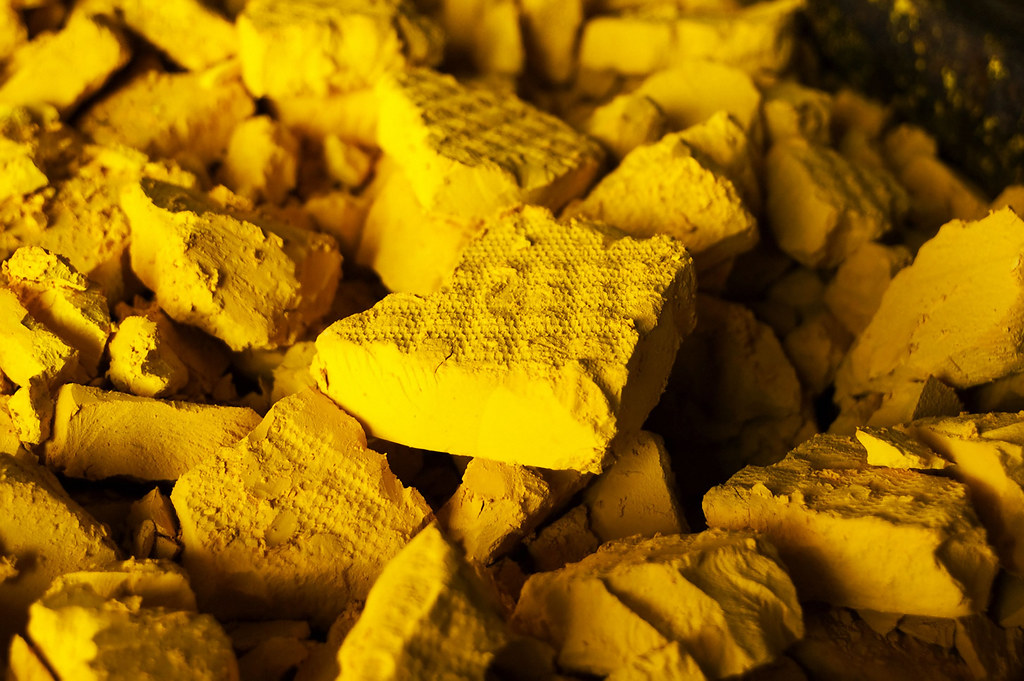Investors have a
new opportunity for a stake in nuclear power.
Last week a successful initial offering was staged by a new player in
the uranium supply chain. Yellow Cake, plc.
sold 76 million shares at £200 per share, raising £151 million (US$200
million). Uranium Royalty Corporation took US$25
million of the deal, giving the Canada-based uranium speculator a 16% stake in the
company. Yellow Cake is listed on AIM
under the symbol YCA. In its third day
of trading the stock closed up 1.25% from its debut.
Yellow Cake
means to be a player in the uranium market, buying and holding a stockpile of the
‘yellowcake’ concentrate or U308 from which the company takes its name. The company proposes to act as an
intermediary between uranium producers and nuclear utilities. Management has wasted no time in establishing
relationships and investing its capital
- moves that could set up a compelling investment opportunity for
investors.
 |
| Yellow Cake - U308 |
With the IPO
completed, Yellow Cake is buying 8.1 million pounds of U308 or ‘yellowcake’ concentrate
from JSC National Atomic Company Kazatomprom, a significant uranium producer in Kazakhstan. The purchase is reportedly at a price near US$21.00 per pound. Yellow Cake has also pledged to buy up to
US$100 million of Kazatomprom’s uranium annually for the next nine years. The off-take agreement represents about a
quarter of Kazatomprom’s production capacity.
Well-timed Market Entry
Yellow Cake is entering
the uranium market at a pivotal point in the industry’s cycle. With nuclear power out of favor since 2011,
when a natural disaster cause a massive failure at the Fukushima Nuclear Power
plant in Japan, uranium prices have been at record low levels from a high
around US$70.00 per pound. Indeed, Yellow
Cake just bought concentrate material from Kazatomprom at a price about 8%
below the prevailing spot price near US$22.50, according to uranium industry
analysts at UxC.
The current concentrate
spot price is well below the marginal cost of production for most uranium
producers. As a consequence many uranium
players have shuttered production and delayed exploration projects. Even Kazatomprom, considered to be among the
lowest-cost uranium producers in the world, has announced plans to cut
production by 20% or about 11,000 tons over three years beginning in 2018. Kazatomprom’s announcement was followed a
month later by a similar decision from Cameco (CCJ: NYSE,
CCO: TSX) to suspend
production at its McArthur River mine beginning January 2018.
Since
Kazatomprom is the largest producer in the world, its market moves could have
an impact on the entire industry. The
company’s decision to cut production by 11,000 tons represents about 7.5% of
total global uranium supply while the deal with Yellow Cake soaks up about
5%.
Yellow Cake may
have come to the market at the perfect time.
Many in the industry believe that higher prices are around the
corner. The logic is that as low cost
producers such Kazatomprom and Cameco cut output, there will be pressure on
supply from uranium users coming into the market to replace expiring supply
agreements. FocusEconomics, an industry research firm, has predicted a spot
price of US$26.30 per pound by the end of 2018, representing a 17% increase
over the prevailing spot price.
Industry Cycle Trough
Uranium prices
are determined in a murky environment.
There is no open market for uranium concentrate and therefore no posted
clearing prices. Buyers and sellers
negotiate contracts privately. Nuclear
power producers typically set up long term supply pacts at contracted prices
above the spot price. At the beginning
of 2018, reported contract prices were near US$30.00 per pound compared to the
prevailing spots price near US$20.25.
Uranium pricing is essentially the same worldwide.
Contract prices
are heavily influenced by the uncovered supply requirements of utilities with
nuclear power plants. UxC estimated that
uncovered demand was near 4.1 million pounds at the beginning of 2018. The figure is not significant, but UxC
estimates that from 2018 through 2020 there will be 54.9 million pounds requiring
coverage. After 2020 annual uncovered
demand is estimated to rise rapidly to 150 million pounds by 2025 and over 179
million pounds by 2030. With contracting
activity picking up, the prognosis for U308 prices appears promising and may
prove Yellow Cake’s leadership to be remarkably prescient.
What may be even
more favorable for Yellow Cake and its stockpile of U308 is the gap between
uncovered demand and production capacity.
The predicted 179 million uncovered pounds in 2030, is estimated to
exceed currently planned production capacity by 16 million pounds. The potential for a future supply gap in
uranium could be especially helpful for a well funded intermediary with the
ability to access the capital market and secure off-take agreements with the
largest uranium producers in the world.
Measuring Value
The other collector
of uranium supplies, Uranium Participation Corporation (U: TO) provides a possible comparable for Yellow Cake. Its shares trade on the Toronto Exchange at 9.7
times trailing earnings and 1.1 times book value. That provides something of a ruler to measure Yellow Cake.
Neither the author of the Small Cap Strategist web
log, Crystal Equity Research nor its affiliates have a beneficial interest in
the companies mentioned herein.
No comments:
Post a Comment